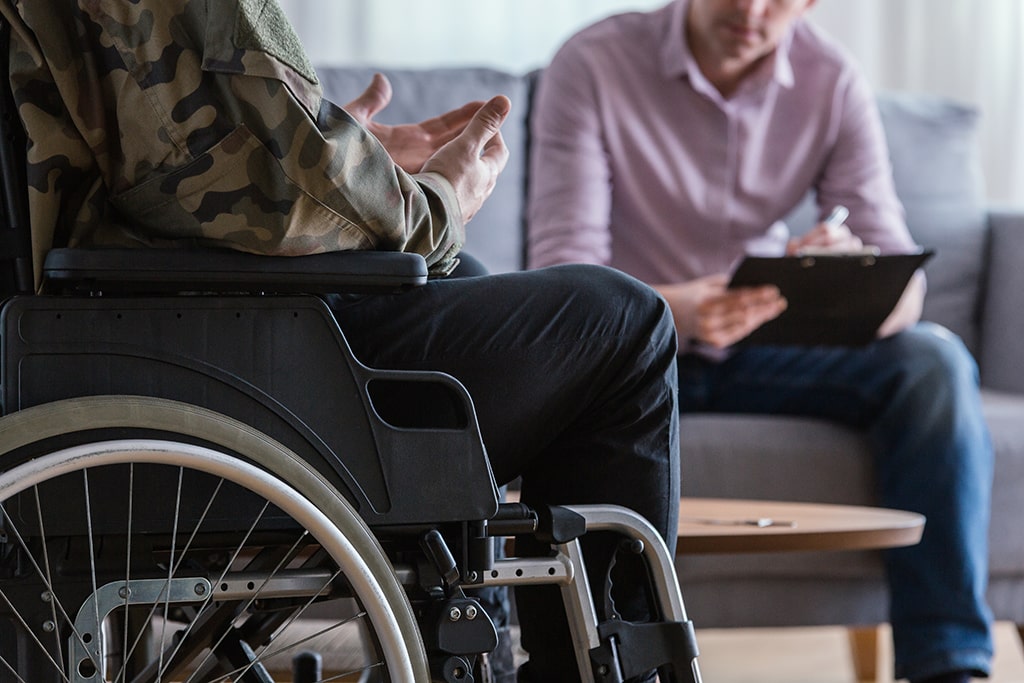Looking for Expert-Level VA Claim Answers?📱Call Us Now! 737-295-2226
A Veteran’s Guide to Service-Connecting Disability Conditions
Veterans living with any kind of disability (from injury or illness) are very likely to have either sustained or aggravated that disability during their time in service. All veterans with illnesses and/or injuries should file a service-connected disability claim with the VA to receive the care and compensation they’re due.

The first hurdle for many veterans is to even think of themselves as disabled or to feel deserving. Many veterans avoid pursuing a disability claim because they think “others are worse off than me,” or “my disability is minor.” Or they’ve brought home a stoic, “suffer silently” attitude from military culture. Sometimes veterans feel ashamed to reveal any weakness or don’t want to be seen as “damaged.”
The truth is, there is no weakness in acknowledging an injury or illness. And if you sustained or worsened any type of injury during your service, you are entitled to care. Disability compensation allows you to receive that care, and it’s legitimately owed to you. It’s important that you receive the care you were promised.
After you realize that you justly deserve compensation for any condition related to military service, there are some concepts it’s important for veterans to understand. Acknowledging your disability is the first step, but once you’re ready to pursue a claim, it’s essential to establish service connection: the link between your disability and your service.
Service connection must be established in a way that the VA recognizes, so that they rate and approve your claim appropriately and offer you the maximum benefits you’re due. There are very specific ways to do this. Understanding the process and meeting its requirements makes all the difference in a successful VA disability claim.
In this guide to service connection and disabilities, we’ll cover important definitions, explain what it takes to service-connect a disability, illuminate the difference between primary and secondary service connection, and introduce key elements of a winning claim. We also point you to further resources.
What is a service-connected disability?
Service-connected means that a veteran’s disability either developed during or was aggravated during active duty. This means it may have been directly caused by military service, occurred while serving in the military (but not necessarily on duty), was aggravated by military service, or was caused by other conditions that are themselves service-connected.
Non-service-connected disability refers to an injury or illness not related to military service.
In order to receive a rating and compensation from the VA, the veteran’s disability must be service-connected. The military disability system is set up to compensate veterans for conditions that are the result of their military service. This ensures that veterans are properly cared for in return for their service, and that taxpayer money is correctly going to help them.
The claims process is largely oriented around proof of service connection in order to ensure that the VA only compensates veterans for conditions caused by military service.
How do I know if my condition is service-connected?
Any current illness or injury (“condition”) that affects your body or mind may be service-connected if youserved on active duty, active duty for training, or inactive duty training, and:
- Got sick or injured while serving in the military—and can link this condition to your illness or injury (called an in-service disability claim), or
- Had an illness or injury before you joined the military—and serving made it worse (called a pre-service disability claim), or
- Have a disability related to your active-duty service that didn’t appear until after you ended your service (called a post-service disability claim)
There are also lists of disabilities that the VA defines as ratable/compensable and those that are not, as discussed below.
Here’s a more in-depth rundown on types of service connection and conditions that can be service-connected.
Conditions Caused While in the Military
The goal of military disability is to compensate all veterans for any conditions that they incurred because of military service. The laws in place define these conditions as ones incurred in combat, on duty, and in training.
This is expanded further, however, to include any and every condition that occurs or is diagnosed during a service member’s time in the military, even when off duty.
Whether a veteran breaks her ankle during training, strains her back while playing sports on the weekend, or is diagnosed with cancer, each of these conditions will be considered service-connected if they occur while she is an active-duty military member.
Conditions Aggravated by Military Service
Service aggravation applies to conditions that were not initially caused by military service, but were significantly worsened directly by service (or by another condition that is service-connected — see Secondary Service Connection below).
Conditions that existed prior to service (EPTS) are not considered service-connected, since they occurred when the service member had no connection to the military. If, however, an EPTS condition is worsened by military service, it is considered service-aggravated.
If a genetic condition develops while a service member is in the military, then it is automatically considered service-aggravated unless it can be clearly proven that the condition would have developed at the same time and to the same degree whether or not the service member was in the military. If this can be proven, then it is not considered service-aggravated.
To determine if a condition was truly aggravated by military service, the seriousness and timing of the condition is compared to the medically-accepted normal progression of the condition. If the condition is clearly worse or occurred earlier than the norm, it is service-aggravated.
Example: If John has a genetic condition that usually starts manifesting at age 40, then it would be considered service-aggravated if it manifested before age 40—say, at age 29.
Any condition not related to military service can also be considered service-aggravated if it is clearly made worse by an already service-connected condition.
Example: Mary injured her knee in the line of duty and developed service-connected knee instability. Later, she is in an accident while off-duty and breaks her ankle. Without the knee instability, the ankle would have been able to heal completely.
However, a medical professional affirms that her service-connected knee instability is making it difficult for the ankle to heal and easy for it to be re-injured. She develops arthritis in her ankle that is caused by the combination of knee instability and the ankle injury. Because the ankle was unable to heal due to her service-connected condition, her ankle would be considered service-aggravated.
Presumptive Disabilities
Some disabilities are “presumed” disabilities.
Over time, the VA noticed trends in medical conditions that veterans developed after serving in certain circumstances at particular times and places. Although there is no definitive medical proof that these conditions were caused by the circumstances of service, there was enough evidence to convince the VA that these associations between medical conditions and specific service environments were not coincidental.
Because of this, the VA compiled the VA Presumptive List. This list affirms that if a service member served in certain places/times and developed a condition on the list, it was caused by that service and is thus service-connected and eligible for disability.
The VA Presumptive List includes exposure to Agent Orange for Vietnam and Korean vets, exposure to radiation, prisoner of war conditions, Gulf War veterans, and more.
Conditions Caused by Exposure
As a part of their military duties, service members are often exposed to chemicals, radiation, or other substances that can negatively affect health over time. If a condition develops after a service member leaves the military that is known to be caused by a substance they were exposed to while in the military, then that condition is service-connected.
The service member must prove that they were indeed exposed to the substance. If exposure occurs, service members should obtain documents detailing exactly what they were exposed to, how much, and for how long.
If you’re unable to obtain documentation detailing your exposure, your condition will only be considered service-connected if it is on the VA Presumptive List.
Secondary Service Connection
Often a service-connected condition can cause additional conditions to appear. Many conditions caused by a primary service-connected condition are considered service-connected by default.
If a secondary condition develops later in life, the VA will consider it service-connected and will provide benefits for it if proven in a claim. This requires submitting a new VA disability claim for that condition.
To support a claim for a secondary condition, a veteran must provide evidence that the new condition is clearly the result of the service-connection condition. A Nexus Lletter from a physician or other qualified medical professional greatly strengthens a claim for a secondary condition.
Secondary service-connected conditions can justly increase your VA disability rating and benefits. Many veterans aren’t aware of the potential for service-connecting secondary conditions. For example, there are a number of common disabilities among veterans that are secondary to PTSD.
Conditions That Aren’t Ratable
All exceptions to service connection can be found on this Conditions That Are Not Ratable page. They can include genetic or hereditary conditions, or conditions that existed prior to service (EPTS).
Proving Service Connection
Service-connecting your disability is a process. It involves submitting specific documentation to show that your conditions meet the requirements for one of the categories of service connection or one of the categories on the presumptive list.
It’s a good idea to file a disability claim soon after leaving service. While it’s possible to file a claim anytime after discharge, there’s no benefit to waiting. When the details aren’t as fresh and evidence could be lost, it can become harder to service-connectyour disability.
Many veterans don’t realize it’s also possible to file a claim up to 180 days before being discharged. This can be done through the Benefits Delivery at Discharge program, which may help your claim be approved at a faster rate.
The fastest way to file and apply for benefits online through the Veterans On-Line Application (VONAPP). You may also apply through the mail by filling out and sending in the Application for Veterans Compensation and/or Pension. This form is available on the VA Forms website and at your local VA office.
Filing can also be done over the phone by calling 800-827-1000, or directly in person at the VA Office nearest you.
Multiple Service-Connected Conditions and VA Disability Ratings
The VA assigns you a disability rating based on the severity of your service-connected condition(s). It uses your disability rating to determine how much compensation you’ll receive each month, as well as eligibility for other VA benefits.
Of course, many veterans have sustained more than one injury or illness as a result of their time in service. Some may be considered non-ratable/non-compensable, but it’s very common for veterans to have more than one service-connected compensable condition.
In addition, it’s possible to have a mix of primary service-connected conditions and secondary service-connected conditions. For example, a veteran might have PTSD and a knee injury sustained in active duty—two unrelated service-connected conditions. That veteran might also have two secondary service-connected conditions—sleep apnea secondary to PTSD, and a right knee condition that a medical professional has confirmed is secondary to the primary left knee injury acquired in service.
How these conditions are compensated depends on how your conditions are rated by the VA. That’s why a fully-developed, well-documented VA claim is so important, and why the Compensation and Pension exam must be handled correctly.
If you have multiple disability ratings, the VA uses them to calculate your combined VA disability rating. Calculating your combined disability rating involves more than adding up your individual ratings. The VA Service-Connected Disability rating system is complex. It’s sometimes called “VA math” and it can be challenging to understand.
The bottom line, though, is that your combined rating may be different than the sum of your individual ratings—it’s not as simple as “this condition has a 20% rating and the other had a 30% so your rating is 50%.”
Although it can be complicated, it’s important to understand the math involved in how your rating is determined, so you can be sure your benefits are calculated correctly. The difference can literally be worth thousands of dollars a year in benefits.
For more on “VA math” and how your ratings are calculated by the VA, see our VA Disability Ratings Calculator.
Filing a Successful Service-Connected Disability Claim
About 30% of VA Claims are denied, and it’s estimated that roughly 60% of those denials are made in error. (In addition, even for those not outright denied, eight out of ten veterans are underrated for their disabilities.)
One of the main reasons so many claims are rejected (or underrated) is that many veterans file without preparing correctly. It’s extremely important to have all the essential documentation in order (without excess), including evidence that undeniably service-connects your disabilities.
The problem isn’t always a lack of information; sometimes it’s too much. While key evidence supporting your claim must be included, those crucial specifics can get lost in hundreds of pages of medical records amid thousands of claims daily. Unfortunately, VA reviewers don’t have time to pore through excess files to find the best and most relevant evidence.
When the VA receives a fully developed, tightly formulated claim, it can be reviewed and processed much more quickly. The most critical information is much less likely to be missed.
Once denied, it can take between 12-18 months for an appeal to be decided. These are precious months you could be receiving benefits and care—time and money you cannot get back. That’s why it makes sense not only to file as soon as possible, but to investigate thoroughly what it takes to mount a fully-developed claim.
Have a plan while putting your claim together. Know what the VA requires for approval and do your best to understand their process. (At VA Claims Insider, we can help with this; find out more here.)
THE NUMBER ONE REASON VA DISABILITY CLAIMS ARE DENIED IS LACK OF MEDICAL EVIDENCE.
It’s essential to obtain all the medical records you need to service-connect your claim. This includes medical records before service, but especially any from during your service. The VA will look at these records to find the event(s) that served as the catalyst for your disability, to ensure that the injury or disability is a result of your service.
They will review and compare medical records from before and during service, too, in making a determination.
As the VA looks for proof of a physical or mental disability, they will specifically seek to assess if what you’re dealing with makes you less able to function normally in life.
The more evidence you can provide that proves your disability started during military service, the better. Any events, injuries, or illnesses that occurred while serving in the military should be recorded and presented with your claim. Document may include:
- Service treatment records
- Medical evidence related to illness or injury (including X-rays, doctor’s reports and medical test results
- Separation documents like your DD214
Nexus Letters from independent medical professionals post-service can help tremendously to prove a current disability is connected to earlier service. Even evidence like buddy letters and personal statements can be used as evidence to prove your claim.
The VA will require all these documents to be submitted or that they are given permission to access them.
5 SECRETS to Increase Your Service Connected Disability Rating!
.embed-container { position: relative; padding-bottom: 56.25%; height: 0; overflow: hidden; max-width: 100%; } .embed-container iframe, .embed-container object, .embed-container embed { position: absolute; top: 0; left: 0; width: 100%; height: 100%; }Why you should file a claim even if you think your disability is”mild”
As mentioned earlier, many veterans don’t bother with a VA claim because they don’t think their condition qualifies them as “disabled.” Or, they believe their disability is so mild that it won’t be approved or rate highly enough to provide meaningful compensation.
First of all, you might be surprised at how many conditions may qualify for service connection and for compensation. Check out the complete list in this post.
The fact is, though, that even an initial 0% rating can be helpful, as it gives the VA a point of reference for the future if the disability worsens. This actually makes it easier to get an increased rating if needed later.
It’s always worth at least checking out if you qualify—for your own sake and that of your family.
In short, if you’ve served and sustained even a small injury that is not fully recovered, filing a claim is a good idea.
More Resources
How To File An Original Claim
The Complete Service Disability List
If you want help filing a fully-developed claim that will get you the maximum rating and compensation you deserve, we offer a done-with-you coaching and mastermind community supported by veteran peers. Learn more about working with one of our experienced veteran coaches on your VA claim process to secure the VA disability claim rating and benefits you’ve earned for your honorable service to our nation. APPLY NOW to start our free 3-step intake process.
About the Author

Toni Ann Bator
Toni Bator is a veteran coach at VA Claims insider. She was a leader in the non-profit sector for over 25 years, assisting the most marginalized individuals within society. She recently transitioned from the social service sector into professional coaching, and she is now a certified professional coach specializing in positive psychology and well-being. Her father was a WWII Navy Veteran and a Master Sergeant during the Korean War. Her passion for assisting veterans derives from her service to others and her adoration and love for her role model, her father. Toni has a B.S. in Psychology from American International College and an M.S. degree in leadership from Norwich University. Her coaching certification is from the College of Executive
Coaching, an NBWHC-approved program for individuals with graduate degrees. She is Founder of Infuse Leadership, a coaching practice for individuals who are successful externally but struggle internally from burnout and substance use.




